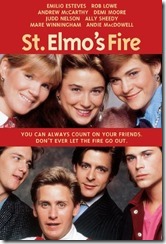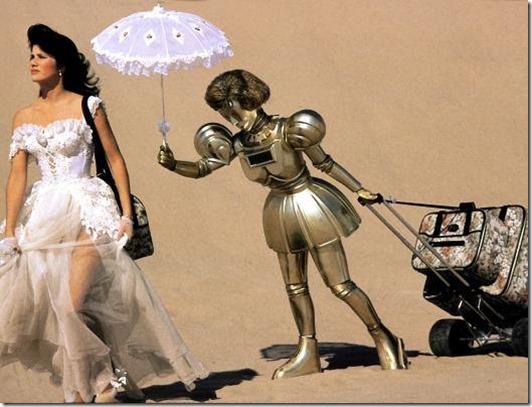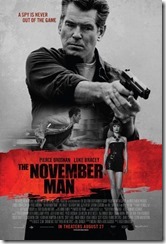When I first started this blog 7 years ago, part of the mission was to highlight movies that were no longer available on the big screen that people should see. Yet I didn’t want to review everything I came across while flipping channels. So any movie seen at home had to be on DVD. That evolved to Blu-Ray, and now it evolves to include Digital (downloaded or streaming). One of the neat things right now is that VuDu and Flixster are running promotions to give you 5-10 movies for free. Unfortunately these are not all good movies, but free is free. I may never watch 17 Again, but it costs me nothing but a little pride by having it in the digital locker. It is through this promotion that I acquired tonight’s subject.
The mid-80s were an interesting time for movies. John Hughes was at the peak with his Breakfast Club/Pretty In Pink crew. Studios kept looking for the next John Hughes-like project to capture those easily spent dollars from teenagers and young 20s. As the Brat Pack started growing out of high school roles, so did the audience. St. Elmo’s Fire was supposed to have the winning formula: 3 cast members from The Breakfast Club (Judd Nelson, Emilio Estevez, and Ally Sheedy), Rob Lowe, and a director by the name of Joel Schumacher. To be honest, the worst thing for this movie tonight was me seeing his name at the beginning; it definitely led me to looking for faults. When this came out in January of 1985 (yes, almost 30 years ago), I was just in 9th grade. I saw the trailer and had no interest in it. As the years went by, I still never found a reason to watch it, despite friends being amazed that I never had. It was the random selection for tonight, as I wanted to watch a movie that I had not seen. Since it has been 30 years since this movie came out, I am not really worried about giving too much away; that said, if you haven’t seen it, know that I am going to be talking about major plot points.
The movie centers around a group of friends that have just graduated college, and are trying to find their way into making that next step in the journey of life. Sadly, the person or persons who wrote this story took the easy path of creating one-dimensional characters. As the plot was being written, one can tell that there is no confidence in the audience to handle the real consequences of certain problems and events of the movie; that results in many of the subplots being trivialized at the end, making the viewer feel cheated of resolution. Here is my breakdown of the subplots:
- Emilio Estevez – In a random emergency room encounter, he spots his college freshman crush, Andie McDowell. Over the course of the movie, he tries to gain her attention and affection. The only problem is that he becomes obsessive to the point of stalking. Yet, he seems fine by the end of the movie after getting a kiss from her. This story seems to fuel the argument that it is ok to stalk women as long as you get some attention from them. Terrible character, terrible actions, absolutely no consequence.
- Demi Moore – Her character is the attention whore of the group. She lives extravagantly and does drugs as a way to impress everyone. Eventually her house of cards falls apart, and she shows depression. Again, though, no consequence, and certainly no discussion of her drug habit. The closest is a 1 minute scene where two of her friends try to talk to her and she runs away.
- Judd Nelson/Ally Sheedy/Andrew McCarthy – This was a cliché nightmare. Judd Nelson wants to be a mover and shaker, and wants Sheedy to be his wife. She wants to take things at a moderate pace. McCarthy spends the first half of the movie dealing with people thinking he is gay. This leads to the stereotypical denials and angry reactions. Of course this was in 1985, when AIDS hysteria was at its height and homosexuals were used as punch lines in movies. So after McCarthy spends the first half of the movie being mysterious, he all of sudden moves in to sweep Sheedy off her feet after she has an emotional breakup with Nelson over his infidelity. Sheedy’s character felt the most genuine through out the movie, which made her one of the few sympathetic characters. McCarthy would have been equal had the story not anchored him with the idiotic gay “red herring” plotline.
- Rob Lowe/Mare Winningham – This was actually the plot line that felt the least contrived. Winningham loves the bad boy Lowe, which is not popular with the family. She also wants to focus on working her job, which allows her to help those in need. yet her family wants her to get hitched to some no-name guy, stay home and spit out kids. The fact that she stays true to her ideals and finally stands up to the family is good character growth. It is her strength in telling Lowe no over and over that eventually gets Lowe to realize that he can’t be “Peter Pan” forever and he must grow up. That said, his character is one that does not deserve any of the rewards he receives.

Ultimately, this movie represents what would happen if the worst of the Seinfeld crew merged with the worst parts of the Friends crew, and you removed all of the comedy. Even those that complained about the group from How I Met Your Mother being unrealistic would find them genuine next to this group of characters in this movie. By the time this movie ended, I was ready to email and call every person who ever told me to watch this movie, and ask them for $8 to cover what I would have paid to see it in the theaters in the 80s. A majority of the characters are irredeemable and everything that was made to feel important at the beginning was thrown away by the end of the movie.
My advice: Skip this movie – there are so many better movies out there. Instead, spend 4 minutes and watch the only good thing to come out of the movie: John Parr’s song, Man In Motion…
St. Elmo’s Fire (Man in Motion)–John Parr



